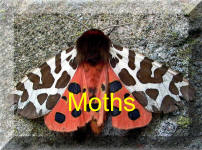2028 Pale Tussock Calliteara pudibunda
Back To
...
Moths Erebidae » Lymantriinae
Wingspan 40-60 mm..-40 mm.
Phenology May and June and are attracted to light.
Description D imorphic; Male female Difference in form - the females are generally larger and plainer in appearance. The males have more contrasting markings and usually smaller. Both exhibit the distinctive forward-facing 'furry' legs at rest.
Life Cycle Larvae are distinctive; similar to that of the Dark Tussock (Dicallomera fascelina), but is generally greenish or yellow, with 4 notable tufts of yellow hairs. It feeds on a variety of deciduous shrubs and trees, and a pest of hop (Humulus lupulus), when it was widely grown.
Habitat





